FIBERS
From the skin of plants such as milkweed, dogbane and nettle the Illiniwek obtained strong fibers
which they twisted into cordage. This was used to manufacture items such as fishing nets and
lines or woven into belts, bags and clothing. The inner bark of the wi-ka-pi or basswood
(sometimes called Linn) tree was the most important source of bast fiber from which the storage
bags were woven. The most common bags (of basswood innerbark fiber and cordage) in the Woodlands,
utilized primarily for storage of dried corn, beans, squash and seeds.
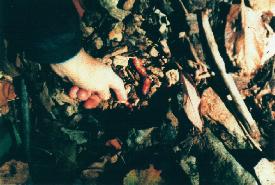 |
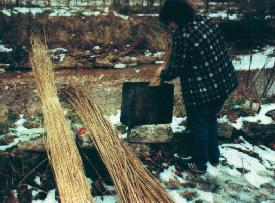 |
| ( click to enlarge ) |
| Ela collects roots of bloodroot in the fall. These are the source of orange/red dye on this bullrush mat. |
Ela dyeing bullrushes for mat.
|
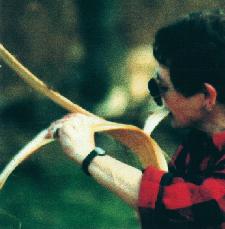 |
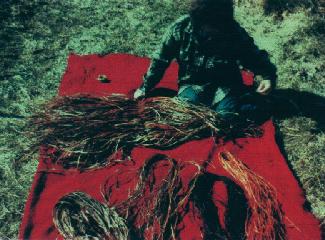 |
| ( click to enlarge ) |
Ela processing basswood innerbark
for use in storage bags. |
Ela beginning the weaving on a storage bag.
|
Mats for covering winter house frames were sewn using wi-ka-pi string and a needle made of
buffalo rib, from cattail leaves which were gathered in the swamps or river shallows in the late
summer. These made a windproof, waterproof wall. Mats for sleeping and sitting on inside the
houses were woven, using wi-ka-pi string, from bulrushes. These were woven in bright plaids,
using natural dyes such as dock root, blood root, nut hulls (especially black walnut), tree barks,
berries, copper, etc. Baskets were also patterned with colors.
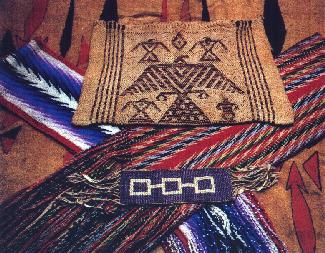
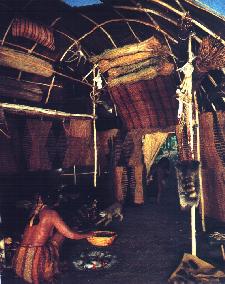
( click to enlarge )
(left) Collage of Ela White's weaving on an elkskin painted by John: twined "panel bag" ( made of wi-ka-pi and buffalo wool cordage, the top was closed by lacing the rim tightly together ) with thunderbird
motif illustrating one of John's traditional stories; an Assomption (Voyageur) sash replicating one in
the Milwaukee Public Museum; centre flache sash with beaded fringes. Wampum belt by John White.
(right) Interior of house diorama at New York State Museum (Albany), from photo published in Museum magazine. Ela provided all the weaving for this house, which creates the atmosphere of a real house and real life. Twined striped storage bag of basswood fiber hanging from roof, completed cattail mats in storage for winter hanging from roof, bundles of raw materials hanging from rafters, striped cedar-bark mat above door, diamond patterned bulrush mats around walls, twined nettle-fiber skirt on woman, twined basswood-innerbark skirt hanging on front of storage platform. More bags and fish nets outside photo.
|
WOOD
The Illiniwek made wide use of the many varieties of trees that grew in their country. From the
great cottonwood and cypress trees they made the 40-foot dugout canoes or Missouri so
important to their economy. With fire they felled the tree and with fire they would hollow it out,
charring the inner or outer surfaces and scraping off the coals with shells or copper tools
The burls or knots that are sometimes found growing on tree trunks were carefully split off and
then, with burning and scraping, shaped Into bowls or feast spoons. The finished objects were
then smoothed and polished and admired for the beauty of the wood-grain patterns.
Tree-trunk mortars and pestles for cracking and grinding corn were also widely used, made in
the same manner of burning and scraping.
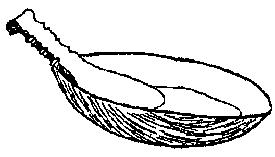
Wooden bowl and spoon. |

Mortar "sa-sa-quah-mu"
and pestle "e-sa-kin-da-que." |
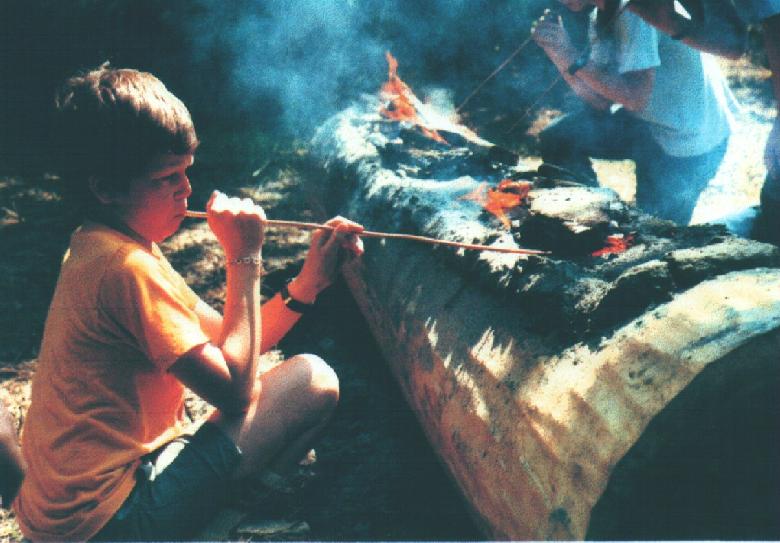
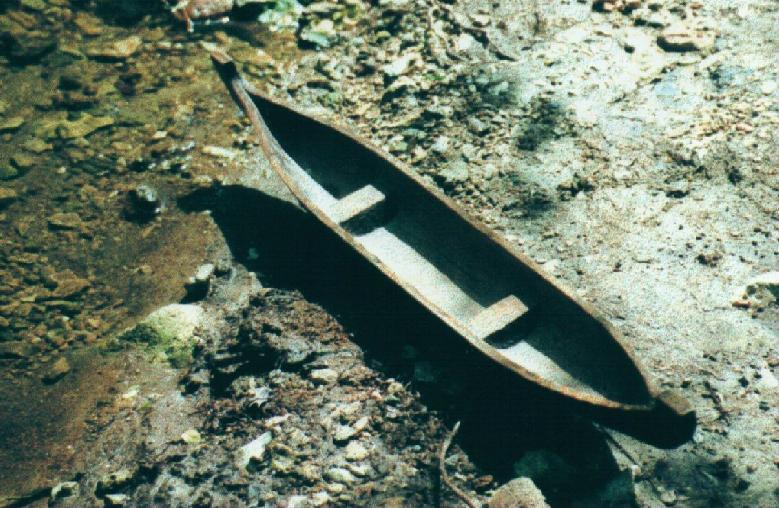
( click to enlarge )
(left) Field school students beginning work on a dugout canoe.
(right) Small model of Native dugout canoe.
|
CLAY
Illiniwek potters made a variety of cooking and storage vessels, some of them were quite large.
The outer surfaces were sometimes textured by use of a stick wrapped with wi-ka-pi (basswood
inner bark) cordage. This tool was rolled over the damp pot which gave the clay surface
somewhat the appearance of a coarse textile. Some pots were decorated around the rim with
incised or engraved patterns but these tended to be more plain than those found further south or
to the north. The potters used wooden paddles, bone and shell tools, as well as the cord-wrapped sticks, for forming and decorating

Illiniwek cooking pot,
about 18" high.
|

Tools used for shaping and decorating pottery by Illiniwek potters: paddle and cord-wrapped stick.
|
FLINT or CHERT
The Lower Illinois Valley is famous for the light colored chert that occurs in the limestone. (Flint
forms as nodules in chalk, usually in Europe.) Knives were, of course, necessary for the
preparation of food and fibers. Projectile points and scrapers were important for hunting and the
processing of hides.
Cobble stones of igneous rock (usually granite) brought down by glaciers of the Ice Age. were
used as hammers to reduce large pieces of chert to a manageable size. Various tools made
from heavy sections of elk antler were used to thin and further shape the chert flakes while deer
antler tines or copper pressure-flakers were used to give the final form.
The time periods and cultural preferences determine the exact shape of the point while the
resources available determine the material from which it is made. Once the technique is
learned, a point can be made in less than five minutes.
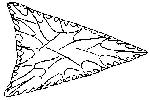
Illiniwek arrow point. |

Illiniwek knife - a point hafted onto a wooden handle and tied with sinew or wi-ka-pi string. |
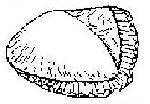
Chert scraper used for many chores. |
|